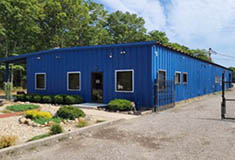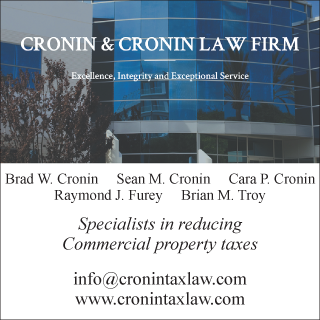Commercial Classroom: Back to basics of industrial buildings - by Edward Smith

Industrial properties traditionally consisted of three major groups: warehouses (used for storage, production, and manufacturing), research and development (R&D) and distribution.
Warehouses may hold goods for a long period of time. The ability to store or stack goods changes the focus with most industrial buildings from square footage to cubic space; ceiling height being a significant measurement. Under steel (US), i.e. 24’ US, twenty-four feet under steel is the measurement from the floor to the bottom of the steel girders that support the roof. Goods may not be stacked higher than the bottom of the roof supports. The distance, span, between the columns that hold up the roof is important to many businesses especially if they store trucks or vehicles in the building.
Access to these buildings may be by overhead doors (like a garage door at a home, but large enough for a tractor trailer truck to enter). Loading docks are platforms of a height that match the bed of a truck allowing goods to be rolled off the truck. Tailboards allow a truck to back up to a building entrance (usually the size of the rear of a truck bay) and roll goods off the truck. Sometimes a declining ramp is constructed below grade to allow this function. Listings should indicate how many of each type of loading facility the building has.
Generally, warehouses contain 10% office space. Their size is described by their square footage, which is measured from the outside of the building including the thickness of the exterior walls.
A factory or manufacturing plant is an industrial site, usually consisting of buildings and machinery, or more commonly a complex having several buildings, where workers produce, manufacture, or assemble goods or operate machines processing one product into another.
We find R&D buildings are generally half laboratory for research and development of new products and the balance of the building is used for storage.
Distribution centers may hold goods for a short period of time, often having access from two sides of the building. Visualize a food distribution center having trucks delivering full loads of one type of product, meats, dairy or produce on one side and other trucks on the other side picking up portions of all the products for delivery to grocery stores.
The advent of e-commerce has developed another type of distribution building that offers bulk storage and acts as a “last mile fulfillment center” with small trucks making local deliveries. Amazon has 110 fulfillment centers in the U.S. ranging in size for 600,000 s/f to 1,000,000 s/f.
In recent years another term has been added to descriptions of industrial buildings in some areas, flex buildings. It is actually not a building but rather a type of zoning. Over the years products have gotten smaller and overnight delivery of most products is now possible. Consequently, demand for some of the warehouses in the 75,000 – 100,000 s/f range has been reduced. With no tenants or buyers interested in these buildings, the owner cannot afford to pay their mortgage and the real estate taxes are not getting paid as well. The local municipality needs their real estate tax revenue so they rezone the property from industrial to flex zoning allowing multiple uses in the building. Now the building may be used in part for offices, part retail showroom, some self-storage or even apartments, restoring the tax revenue.
Key concerns of industrial “users” also includes amperage (power in the building), sprinklers, floor load (literally how much weight can a floor support, especially important in multi-story buildings), and available technology access. The current occupant may not use computers, but your customer may be very hi-tech. If the building is not currently “wired” find out what phone and internet access services are available – your customers will want to know.
Industrial companies may be somewhat flexible as to the location of their facility, but need to consider access to major highways, transportation expenses, labor availability and labor costs. Employees may require access to mass transit.
Sale listings for industrial buildings typically quote the price per square foot as buyers compare this cost with other buildings and new construction. Often an industrial owner will list properties for either sale or lease (make sure your listing agreement covers both contingencies).
During the pandemic to today the demand for industrial buildings has increased dramatically. The 3rd quarter of 2022 demand was up 13.5% over 2022. Vacancy averaged only 4% in 2022. Low inventory and higher demand created higher rents and sales prices. In addition to the traditional uses we are finding many retail businesses seeking industrial storage space for their overstocked merchandise.
A problem that does exist is that 70% of industrial buildings were built before the 21st and 1/3 of these buildings are over 50 years old. New construction was halted or delayed during the heart of the pandemic due to building materials and labor shortages. However now there is over 500 million s/f in construction, expected to be completed in 2023, which will start to keep up with demand.
These new buildings will be more people and environment friendly featuring high leverage ventilation systems and other green policies and procedures. Warehouses will feature high-tech production and automation. Delivery vehicles are going electric. All to provide a healthier work environment and help reduce carbon emissions.
Many companies are re-evaluating their supply chains and we are seeing a trend back to onshore manufacturing, USA production.
Tenanted industrial buildings may also be sold as investments. These investments tend to have less turnover and longer leases. Many are Triple Net (NNN) leases with the tenants responsible for maintenance, real estate taxes and all other expenses. They are effectively renting “empty boxes” with no need for expensive buildouts and rarely need renovations.
Investor concerns today include the high cost of capital, a slowdown in rent growth and tenant performance. Tenants are concerned with the economy and their businesses performance. Consequently, they seek flexibility in their leases, ability to sub-lease and other escape clauses.
Overall industrial buildings stood the test of time and thrived during the pandemic. I think the key word for today is stabilization. The values (rent and sales) will hold for now but as the new inventory completes construction vacancy will gradually increase and create future price competition.
Edward Smith, Jr., CREI, ITI, CIC, GREEN, MICP, CNE, e-PRO and CIREC program developer, is a commercial and investment real estate instructor, author, broker, speaker and a consultant to the trade.
Suffolk County IDA supports expansion of A&Z Pharmaceuticals


The evolving relationship of environmental consultants and the lending community - by Chuck Merritt
When Environmental Site Assessments (ESA) were first part of commercial real estate risk management, it was the lenders driving this requirement. When a borrower wanted a loan on a property, banks would utilize a list of “Approved Consultants” to order the report on both refinances and purchases.








.gif)
.jpg)